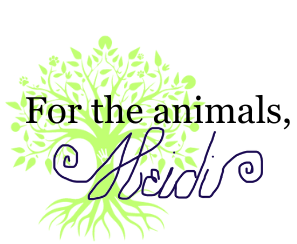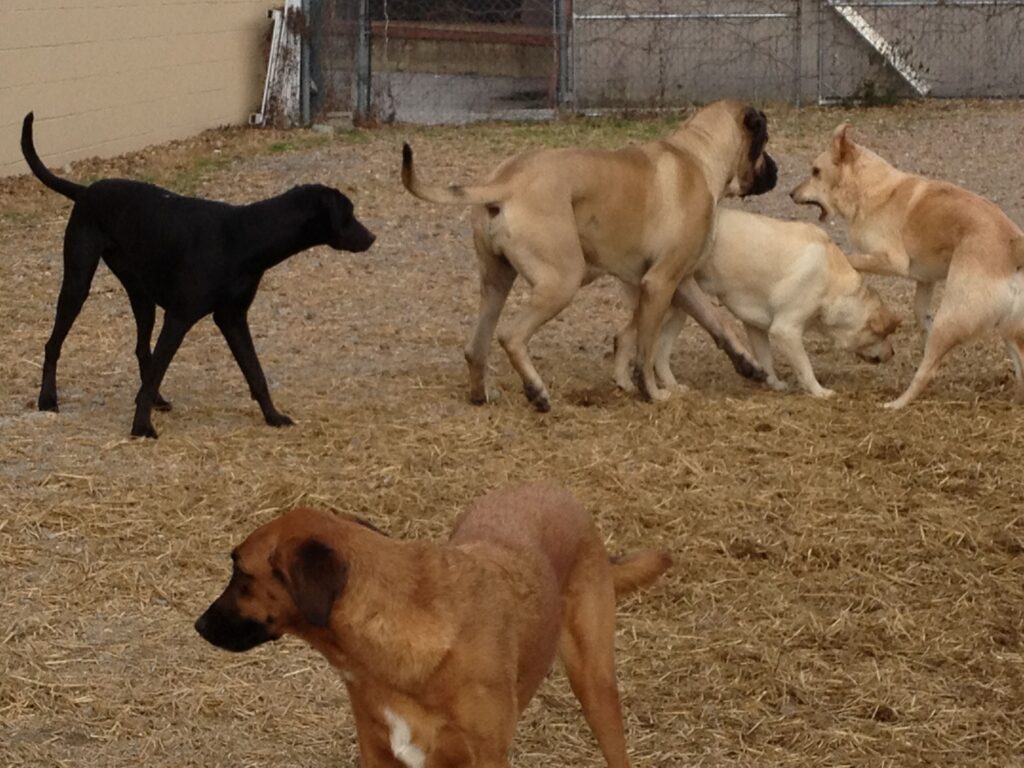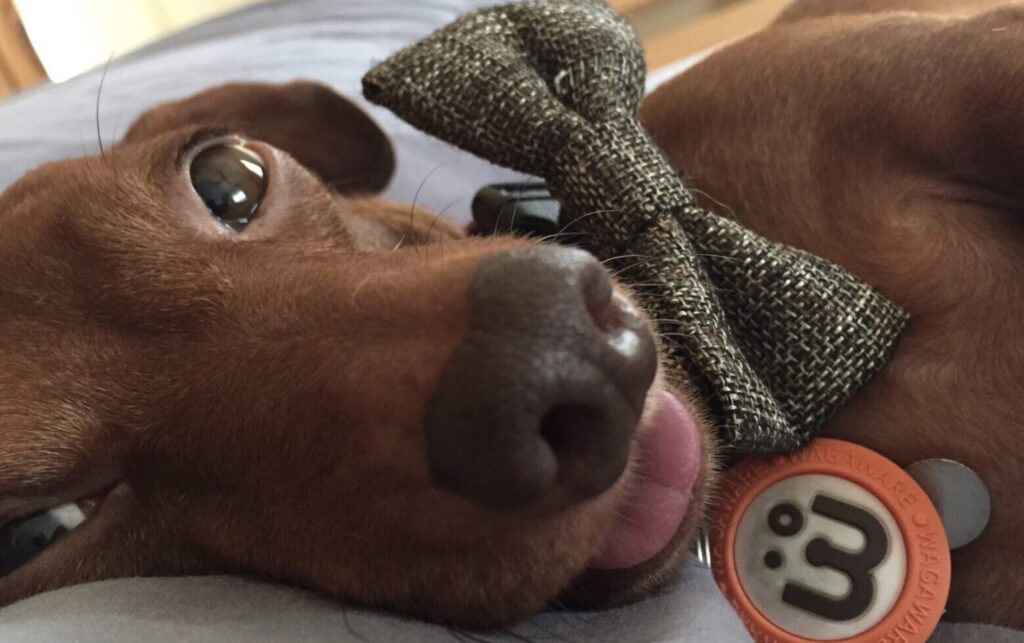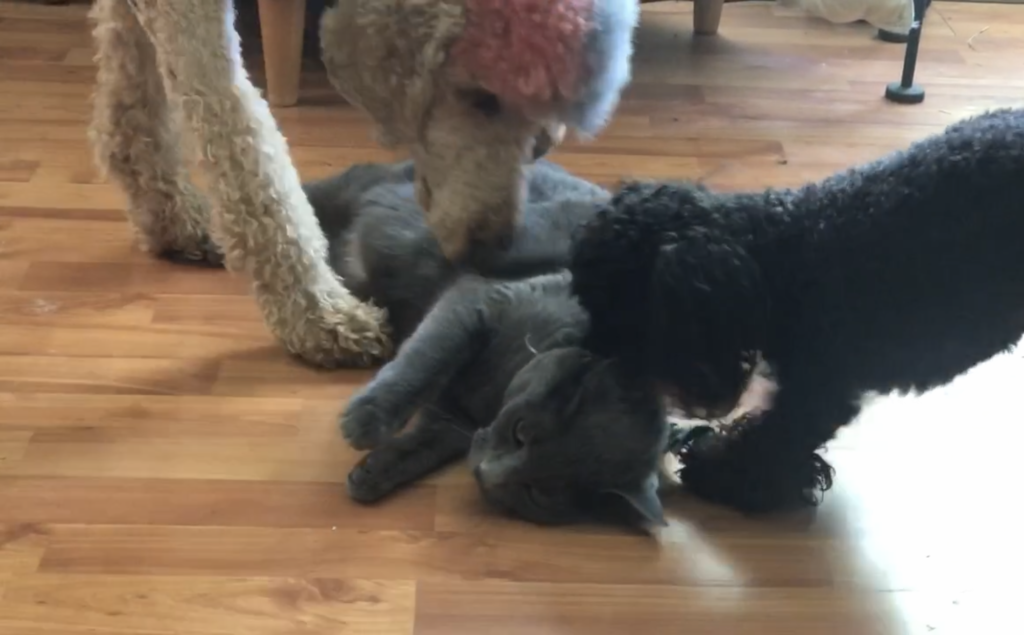Do things other people do ever make you angry? You’d have amazing self-control or be highly evolved spiritually if you never lost your temper!
Don’t be surprised when dogs do it too. We may yell and flip people off. Dogs growl, bark, and may even get physical to solve a problem. The image of an angry dog driving a car is worth consideration…
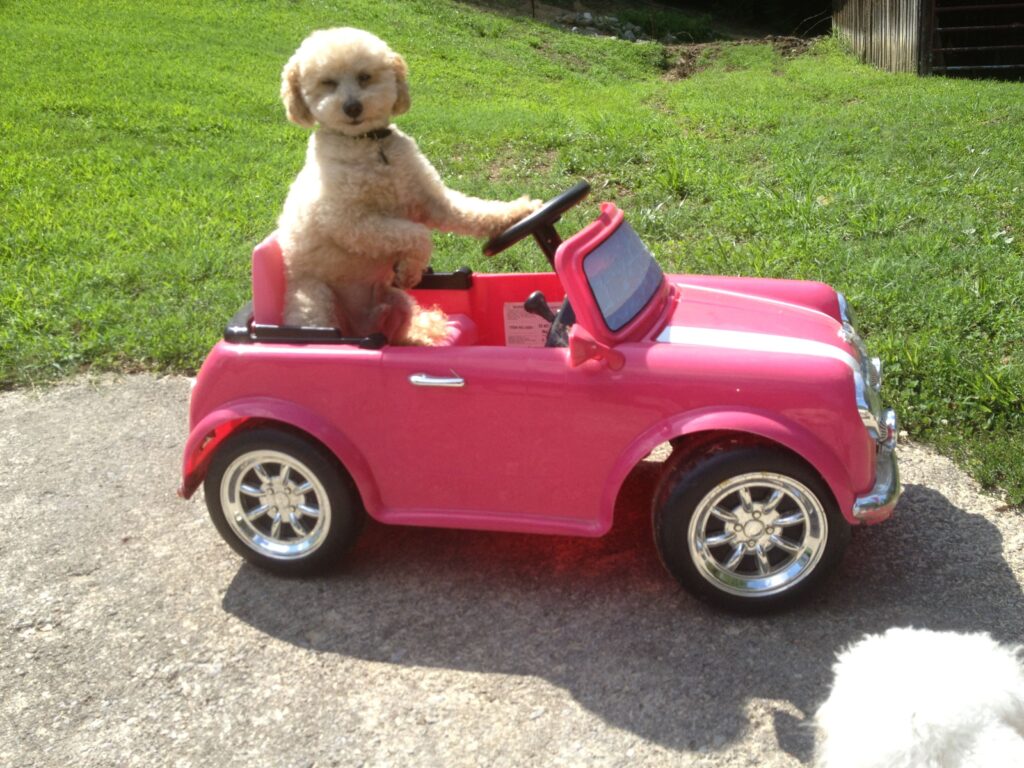
Dog Language
Just like us dogs communicate constantly. We can learn to read their body language warning signs with practice. Brain-to-brain (b2b), aka telepathy, is another way to communicate directly with our best friends.
Scientists who spend time watching animals believe that every movement, no matter how small, has BIG meaning to dogs. Experience taught me that dogs use so many signals to communicate with each other that we can’t catch them all. They’re almost invisible!
When a fight breaks out the dog who seems to attack is most likely reacting to something the other dog “said” long before. Dogs use their bodies — eyes, mouth, tails, hair along the back and neck, ears, etc — in addition to direction of movement, sounds, and b2b to communicate.
An interesting article in Scientific American, The Ethical Dog, suggests morality in dogs because of the meaning bowing to each other during play holds and what happens if they use it to lie. Body language is very important.
WilloWisdoM continually adds content — blog, video, and podcast
to help you. Feel free to reach out!
How Can You Help Your Dog Avoid a Fight?
Older dogs with good communication skills teach puppies how to be social. Learning from and spending time with social dogs — who have play and conflict resolution styles that are healthy and effective — is important for social behavior throughout life.
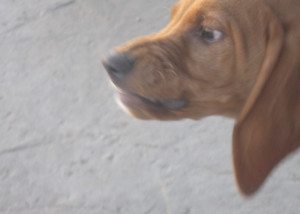
Puppies who grow up playing daily with mature dogs who have good play-styles tend to keep them as adults. Safer play may start with small dogs while they’re also small and eventually learn from social and mature dogs their size and larger as they grow.
Pay attention. Puppies may stop listening to their elders if they’re too small to control the puppy. Remove the puppy to a larger, gentle dog with great social skills. Hopefully, a social dog their size will eventually be able to teach them to behave.
Puppies shouldn’t be allowed to bully older dogs. Get help from a professional trainer if this happens or you’ll have a dog no one wants to play with when they grow up! We can help!
Puppies are most open to new experiences in the first few months of life.
It’s ideal for socialization to spend 10 weeks with their mom and litter before adoption. When your puppy is home, take them out and about right away. Before allowing the pup to play directly with dogs outside their family, it’s wise to complete early vaccines. Your vet can help decide what’s needed. I use Dr. Jean Dodd’s vaccine protocol as well.
Ideally, dogs continue engaging with their species throughout life although it isn’t as critical after adulthood. Most dogs, giant breeds excepted, enter adulthood around eighteen months to two years of age.
Socializing
Daycare can work great for puppies. Adult dogs don’t always appreciate it. It can be too stressful to be around a bunch of strangers as an adult. I wouldn’t enjoy clubbing nightly with 20-year-olds, no offense guys, I’d prefer to stay home and read a book.
Dogs are less likely to socialize outside their family than most people If your dog doesn’t like daycare, it’s ok. Prime socialization is believed to be within the first 3 months of life. Most animals appreciate an opportunity to be with their kind.
Dog park visits can help too if you stay on your toes. The following points are important so you and your dog can stay as safe as possible. If you observe people who aren’t paying attention to their dog or dogs who are not well socialized, it may be best to leave and revisit at another time. Visit dog parks with caution and be ready to leave quickly.
If daycare isn’t your dog’s thing, dog parks with strangers won’t be either.
Well-run daycares work better than dog parks because dogs make friends and are excited to see them again. If daycare is an option for you, try one day a week. Add or remove days depending on how your dog does at daycare and how they do when they come home. How often they enjoy being in a social setting will probably change during their lifetimes. At home, your dog should be ready to rest with you and be excited to return to play in a day or so.
How do they act when you go back? They should be happy to return once they get used to it. Each dog is different. Some are comfortable right away. Others may need several visits. Most dogs need to go weekly to be most comfortable and maintain friendships but all dogs are different.
Don’t keep pushing them if they don’t want to be there. Trust your dog.
I caution many people against watching cameras. Dogs rest a lot more than we do and people may feel their dog isn’t doing enough. If you do check-in, dogs should have minutes of play followed by much longer periods of rest.
Avoid care where dogs spend the whole day moving around. At my daycare, we let the dogs set the pace and found that having a person in the group all of the time made it hard for many dogs to take a break.
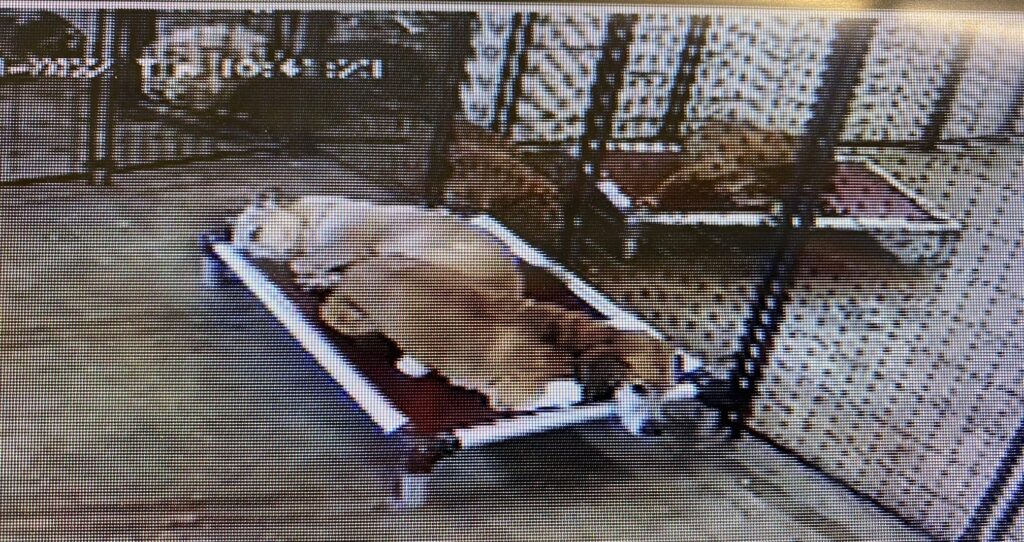
Dogs can be competitive for any human attention, especially when you’re not around. We watched cameras and listened for upset dogs instead of being visible in their space.
If daycare is not an option, look for meetups in your area, neighbor or family dogs who your dog enjoys and are close by, or take your dog with you to dog-friendly places. Ongoing classes that emphasize cooperation and avoid techniques your dog finds frightening or painful will help with boredom and should keep your bond tight.
You are your dog’s family. Their favorite activity is probably spending time with you. Adding another dog or companion animal to be close to when you’re gone is ideal for most. I’ll add a blog post on selecting a second dog soon.
Teach your dog to respond quickly to their name and come when called.
This is the best way to keep your dog, and you, safe in pubic. If our dogs respond immediately to our calls and we know what to watch for, we can safely end interactions that aren’t going well. If you’re ever uncertain, try a call out.
- Call one dog and keep them with you.
- If the other dog follows to keep playing, they are probably enjoying the experience. Let ’em play!
- If you call a dog and their playmate wanders off they probably weren’t playing.
- Sometimes what looks like play is a way to manage another dog. It can be tiring and the managing dog may need a break.
- If a dog wants a break and the other dog won’t give it to them, distract or hold the player.
- Stop them from playing with the other dog. If you have to, leave the park or remove the annoying dog.
Teach bite inhibition.
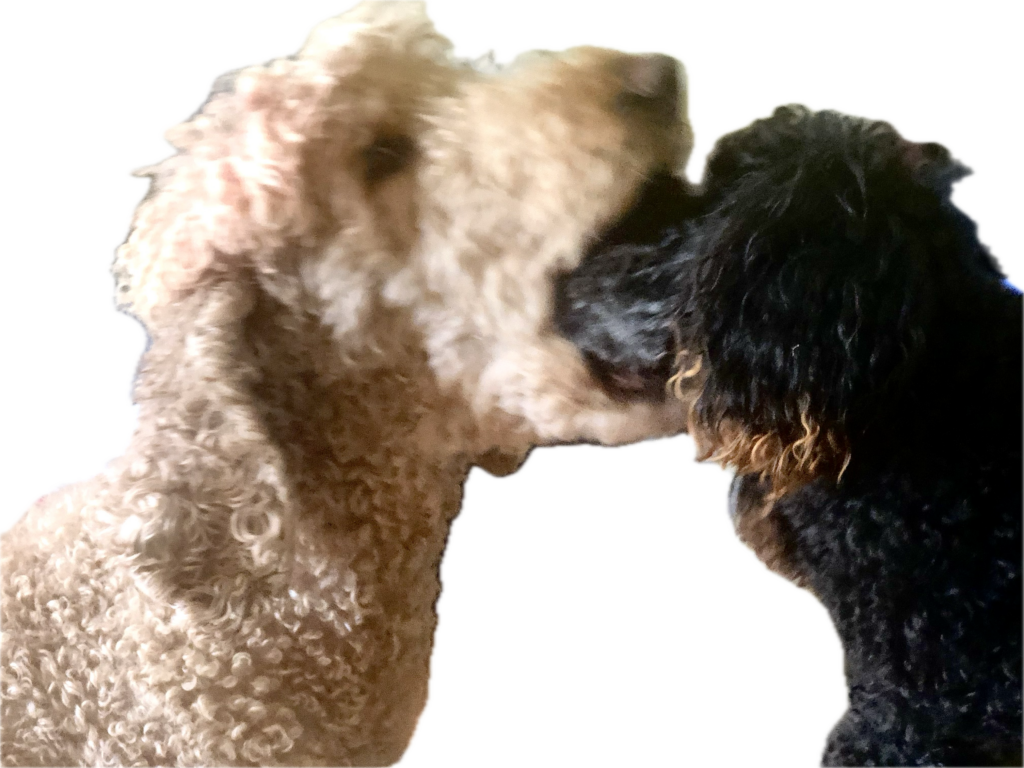
Dogs are great at adjusting jaw pressure to avoid injuries. They obviously learn that different beings are more or less sensitive and adjust. Isn’t that amazing? Dogs know we’re not dogs.
While we can and should teach our pups not to bite hard when they play with us, dogs learn fastest from other dogs. They notice what ends a fun romp and, if they keep pushing, what gets a correction. Puppies want to play. Great experiences like this make dogs less likely to cause injuries throughout their lives.
Puppies learn best from other dogs but we can mimic what social adults do with some success. I can tell you that dogs who are good leaders don’t teach others with aggression. Removal from the action is your best bet. See other posts and social media for more information or reach out!
ALPHA ROLLS ARE WRONG
Dogs who are good leaders don’t roll other dogs onto their backs to teach them to behave.
∞
A person using an aplha roll on a dog is aggressive and it’s risky.
Many dogs will come up fighting. I would.
∞
We can’t teach good social behavior by being aggressive.
Dogs learn to use pressure that won’t injure another dog but can be too hard for people. While most spats between social dogs result in no injury to them, a human trying to pull dogs apart is more likely to get a puncture or torn skin. The dogs are expecting another dog, not you. If they’re really into it, they probably don’t even know you’re there.
We increase tension and our chance of injury when we put our hands on fighting dogs or otherwise get in their way. Teach your dog to come when called and not to bite too hard. That’s the key to safety especially when a meeting goes wrong.
Take classes together that help build a bond.
Partners benefit from a bond built on trust and cooperation. You and your dog will find training and communication easier, both physical and b2b-ca. Enroll in group classes that teach you more about dog body language, like those we offer.
Look for classes that include time for dog play and have an expert guide to help you understand it. Understanding dog communication increases safety.
Resources
There are many great books to help, a few mentioned below. I encourage purchasing or borrowing them. Our local and loyal customers may be able to check one out from WilloWisdoM. Amazon and DogWise.com are great resources for purchase. Hopefully you’ll find our podcast helpful as well as it grows!
Calming Signals: On Talking Terms With Dogs, by Turid Rugaas
It’s a quick read and very enlightening. It can help you learn what to watch for to stop trouble before it happens.
Dog Language – An Encyclopedia of Dog Language, by Roger Abrantes
A guide to canine body postures arranged from A to Z written by a scientist who specializes in animal behavior.
WilloWisdoM Podcast: about b2b-ca = brain to brain companion animals, aka telepathy
